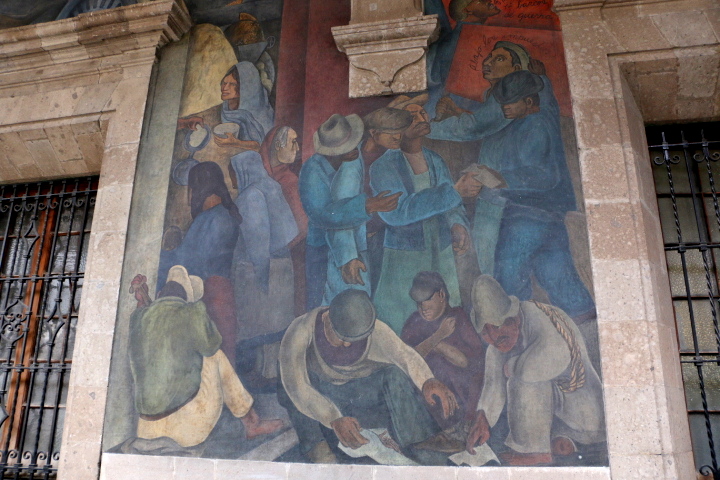On Venezuela Street, in the Centro Histórico—a few blocks north of the former College of San Ildefonso (National Preparatory [High] School) and the Secretariat of Public Education with their murals by Diego Rivera and José Clemente Orozco—is the Abelardo Rodríguez Market. The venue is very different from the official government buildings of the Secretariat or the former High School. But here, virtually hidden in plain view, sit historical and artistic treasures from the era that emerged out of the Mexican Revolution and that fell, increasingly, under the shadow of an impending World War.
Motivated by the populist values of the Mexican Revolution, the Market was built in 1934, during the interim presidency of Abelardo Rodríguez (1932-34), as a prototype integrating a modern, indoor marketplace—replacing street stalls—with community social and cultural services, including a day care center and a theater.
 |
| The grand colonial entrance was originally part of one of the outside corridors of the old Colegio Máximo de San Pedro y San Pablo de la Compañía de Jesús (The Supreme School of St. Peter and St.Paul of the Company of Jesus,i.e. Jesuits), |
 |
| Steel and glass-roofed market |
 |
| Community theater Proscenium decorated with folkart-style flowers and birds by Antonio Pujol |
Joint Mexican-American Project
However, the Market's most distinctive feature is the approximately 1,400 square metres (15,000 sq. ft.) of wall and ceiling space covered in murals painted by a group of ten artists: six Mexicans and four from the United States, all under Diego Rivera's supervision.
The Mexicans included Ángel Bracho, Leopoldo Méndez, Antonio Pujol, Miguel Tzab, Pablo Rendón and Ramón Alva Guadarrama. Most had studied at the National School of Plastic Arts, the post-Revolutionary name for the Academy of San Carlos, where Rivera, José Clemente Orozco and David Siqueiros had studied. All would have careers as painters through the middle of the 20th century, contributing to and broadening the Mexico Mural Movement.
The four artists from the U.S. were Paul "Pablo" O'Higgins, who had emigrated to Mexico in 1924, sisters Grace and Marion Greenwood from New York City, and Japanese-American Isamu Noguchi.
1930s: Between Revolution and World War
In the foyer of the community center section, we get our first taste of political art — it takes us back to Rivera's own militant Ballad of the Revolution in the Secretariat of Education.
 |
| "Strike Against the Imperialist War". Hitler was on the rise in Germany, and Spain was in the turmoil that led up to the Spanish Civil War in 1936. World War II was to break out soon after. |
 |
| Warmongering imperialist capitalists. |
Several of the Mexican painters were members of the Mexican League Against War and Fascism, an affiliate of the World Committee Against War and Facism, a communist and pacifist organization founded in Europe in 1932 in the face of Hitler's rise in Germany and Japan's invasion of Manchuria.
They were also members of the Liga de Escritores y Artistas Revolucionarios, the League of Revolutionary Writers and Artists, founded in 1933 by Mendéz, O'Higgins and Luis Arenal as a successor to the Union of Engravers, Painters and Sculptors founded in 1923 by Siqueiros, Rivera and Orozco. The League was the Mexican member of the International Union of Revolutionary Writers, founded by the Third Communist International in the Soviet Union in 1930. In 1937, the League was to be replaced by the Taller de Gráfica Popular, People's Graffic Workshop, also founded by Mendéz, O'Higgins and Arenal with the goal of using art to advance revolutionary social causes. It existed until the end of the 20th century.
Mexican Worker
Moving to the inner patio, we encounter more subdued paintings, more like Rivera's murals of Mexican workers in the Patio of Labor in the Secretariat of Education.
 |
| Mexican street people, by Pablo O´Higgins (Paul Higgins Stevenson) |
 |
| Mexican Madonna |
Counterpoint of Revolution and Everyday Life
The Market is entered from the street by a series of passageways lined with murals—some explicitly revolutionary like those in the entrance foyer.
 |
| "Workers and Farmers United against Imperialism" Note: Top, center, "The Capitalist", protected by his army, reads his ticker tape, below giant, ominous hands. Bottom right, the outcast poor. Possibly by Leopoldo Méndez |
 |
| "We demand bread and work. We struggle against Imperialism." While workers make gold coins for the Capitalists, upper left, the unemployed suffer below. At center right, a worker collects his few coins in pay from the Paymaster, who, behind the barred window, hoards bags of them. |
Others portray workers and la cotidianidad, daily life.
 |
| A totally different style and theme: Workers cut wood to produce charcoal. By Ramón Alva Guadarrama |
 |
| Mercado, traditional street market with deliveries of sugar cane, watermelons, root vegetables, grain |
Yet another style, one I particularly like. I've been uable to find any information on the artist, Pablo Rendón.
 |
| Mural by Pablo Rendón |

Last, my favorite of all:
 |
| Traditional Street Market, or Tianguis. Note the curving, dance-like movement in the arms of the women versus the very angular movements of the men. It could be a Martha Graham dance. |
See more of our series on the Mexican Revolution and Mexican Muralists:
Part I: Bellas Artes
Part II: The Academy of San Carlos and Dr. Atl
Part III: Secretariat of Education, José Vasconcelos and Diego Rivera
Part IV: Secretariat of Education and Diego Rivera's Vision of Mexican Traditions
Part V: Secretariat of Education and Diego Rivera's Ballad of the Revolution
Part VI: Diego Rivera at the College of San Ildefonso
Part VII: José Clemente Orozco Comes to San Ildefonso
Part VIII: College of San Ildefonso and José Clemente Orozco - Continued
Part IX: David Siqueiros, Painter and Revolutionary
Part X: David Siqueiros Cultural PolyforumFor the story of the Mexican Revoluion, see:
Mexican Revolution: Its Protagonists and Antagonists
No comments:
Post a Comment